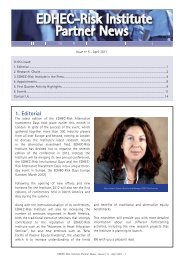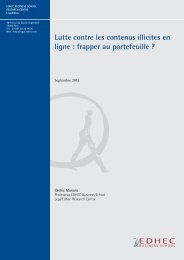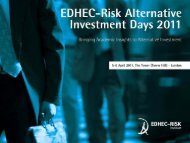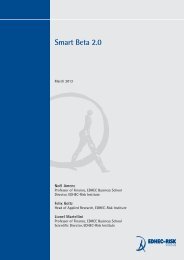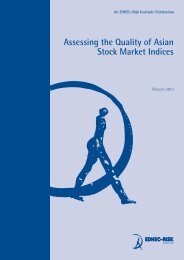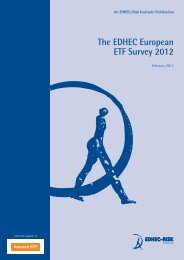The Smart Beta 2.0 Approach - EDHEC-Risk
The Smart Beta 2.0 Approach - EDHEC-Risk
The Smart Beta 2.0 Approach - EDHEC-Risk
Create successful ePaper yourself
Turn your PDF publications into a flip-book with our unique Google optimized e-Paper software.
An ERI Scientific <strong>Beta</strong> Publication — <strong>Smart</strong> <strong>Beta</strong> <strong>2.0</strong> — April 2013<br />
Copyright © 2013 ERI Scientific <strong>Beta</strong>. All rights reserved. Please refer to the disclaimer at the end of this document.<br />
25<br />
2. Controlling the <strong>Risk</strong>s of <strong>Smart</strong> <strong>Beta</strong> Investing:<br />
<strong>The</strong> <strong>Smart</strong> <strong>Beta</strong> <strong>2.0</strong> <strong>Approach</strong><br />
Next we test if the specific risk of liquidity can be controlled using stock selection approach<br />
without compromising the performance of the <strong>Smart</strong> <strong>Beta</strong> strategy. In other words we analyse<br />
if diversification benefits can be exploited in a high liquid stock universe. For this, we construct<br />
four <strong>Smart</strong> <strong>Beta</strong> strategies on the top 50% of stocks in the USA universe in terms of liquidity and<br />
compare their performance with the strategies based on the full USA universe. <strong>The</strong> results are<br />
reported in Exhibit 11.<br />
Exhibit 11: Diversification strategies based on high liquidity stock selection – <strong>The</strong> table shows the risk and return statistics of the Scientific <strong>Beta</strong> USA<br />
strategy indices based on all stocks (in Panel 1) and their high liquidity counterparts (in Panel 2). High Liquidity portfolios are constructed using<br />
the top 50% of stocks in the parent universe in terms of liquidity. <strong>The</strong> analysis is based on daily total return data for the period 21 June 2002 to 31<br />
December 2012 downloaded from www.scientificbeta.com. <strong>The</strong> yield on Secondary US Treasury Bills (3M) is used as a proxy for the risk-free rate in<br />
US Dollars. All averages reported are geometric averages and all statistics are annualised.<br />
Panel 1 Efficient Max Sharpe Efficient MinVolatility Max Decorrelation Max Deconcentration<br />
Ann Returns 7.79% 8.23% 7.60% 8.09%<br />
Ann Volatility 20.49% 18.32% 21.39% 22.71%<br />
Sharpe Ratio 0.30 0.36 0.28 0.28<br />
Panel 2 Efficient Max Sharpe Efficient MinVolatility Max Decorrelation Max Deconcentration<br />
Ann Returns 7.86% 7.88% 7.29% 7.90%<br />
Ann Volatility 21.52% 19.20% 22.60% 24.01%<br />
Sharpe Ratio 0.29 0.32 0.25 0.26<br />
<strong>The</strong> results show that high liquidity stock selection does not have a large effect on the performance<br />
of the strategies. <strong>The</strong> annualised returns tend to be decreased slightly. <strong>The</strong> Sharpe ratios also tend<br />
to be decreased but not by a big amount. <strong>The</strong>se results suggest that by a simple stock selection<br />
approach of selecting the most liquid stocks, one can avoid the liquidity problems of <strong>Smart</strong> <strong>Beta</strong><br />
strategies while maintaining most of the potential for improved risk/reward properties.<br />
Naturally, in addition to, or as a substitution for this stock selection, the construction of <strong>Smart</strong> <strong>Beta</strong><br />
indices can use a second approach to take into account systematic risks linked to investing in <strong>Smart</strong><br />
<strong>Beta</strong>. This approach consists of the well-known constrained optimisation techniques that allow the<br />
maximal or minimal exposures to specific risk factors to be determined.<br />
In this way, nothing prevents investors from having <strong>Smart</strong> <strong>Beta</strong> indices that have, for example,<br />
controlled sector exposures that reduce the difference with respect to the cap-weighted reference<br />
index. Exhibit 12 shows a comparison of performance statistics for the S&P 500 index with<br />
Scientific <strong>Beta</strong> USA Minimum Volatility portfolios with and without sector neutrality constraints<br />
to examine the effect of additional constraints on strategy’s ability to achieve its portfolio level<br />
objective.




